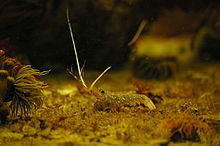Western rock lobster
| Panulirus cygnus | |
|---|---|
 |
|
| Juvenile P. cygnus | |
| Scientific classification | |
| Kingdom: | Animalia |
| Phylum: | Arthropoda |
| Subphylum: | Crustacea |
| Class: | Malacostraca |
| Order: | Decapoda |
| Infraorder: | Achelata |
| Family: | Palinuridae |
| Genus: | Panulirus |
| Species: | P. cygnus |
| Binomial name | |
|
Panulirus cygnus George, 1962 |
|
| External identifiers for Panulirus cygnus | |
|---|---|
| Encyclopedia of Life | 128255 |
| ITIS | 552970 |
| NCBI | 150421 |
| WoRMS | 382893 |
| Also found in: , ADW | |
Panulirus cygnus is a species of spiny lobster (family Palinuridae), found off the west coast of Australia. Panulirus cygnus is the basis of Australia's most valuable fishery, making up 20% of value of Australia's total fishing industry, and is identified as the western rock lobster.
The species has five pairs of legs that are used to move across the ocean floor, the fifth set possessing claws in the female, and six smaller pairs are located at the mouth. The eyes are located at the ends of stalks. They vary in colour from a brownish purple to a pale colour. The exoskeleton is segmented, and must be shed as the animal grows. The largest recorded specimen is 5.5 kilograms (12 lb), but a maximum weight of 5 kg (11 lb) is considered typical. The average accepted form of measurement, that of the carapace, is from 80 to 100 millimetres (3.1 to 3.9 in) in length.
The range of the species is along the coast of Western Australia, from Hamelin Bay to the North West Cape, and at islands such as the Houtman Abrolhos. The larvae of the species develop in the meadows of seagrasses of Western Australia, migrating out from these toward the deeper ocean and coral reefs such as the Abrolhos Islands.
The annual catch is 8,000–15,000 tons. The value of production in 2003/2004 was A$248 million. The fishery was one of the first in the world to be certified as ecologically sustainable by the Marine Stewardship Council. The western coastline contains eight species of rock lobster, but the harvest primarily targets Panulirus cygnus.
The species is known to have been caught since the settlement of Swan River Colony, in 1829, and expanded as the larger populations were discovered in remote locations of the state. The industry came to be centred at the Houtman Abrolhos, at the edge of the continental shelf, where the mature crays occur in large populations. A cannery was established at the islands to export the seasonal catch in the 1930s. The early industry claimed to harvest up to fourteen species, however, research into the Abrolhos populations recognised only three.
...
Wikipedia

